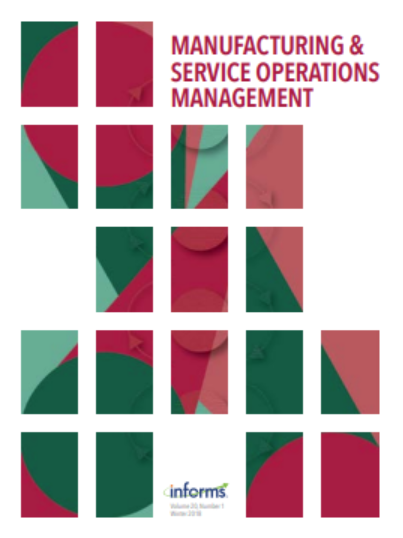Buffer Times Between Scheduled Events in Resource Assignment Problem: A Conflict-Robust Perspective
IF 4.2
3区 管理学
Q1 MANAGEMENT
M&som-Manufacturing & Service Operations Management
Pub Date : 2023-09-26
DOI:10.1287/msom.2022.0572
引用次数: 0
Abstract
Problem definition: In many resource scheduling problems for services with scheduled starting and completion times (e.g., airport gate assignment), a common approach is to maintain appropriate buffer between successive services assigned to a common resource. With a large buffer, the chances of a “crossing” (i.e., a flight arriving later than the succeeding one at the gate) will be significantly reduced. This approach is often preferred over more sophisticated stochastic mixed-integer programming methods that track the arrival of all the flights to infer the number of “conflicts” (i.e., a flight arriving at a time when the assigned gate becomes unavailable). We provide a theoretical explanation, from the perspective of robust optimization for the good performance of the buffering approach in minimizing not only the number of crossings but also the number of conflicts in the operations. Methodology/results: We show that the buffering method inherently minimizes the worst-case number of “conflicts” under both robust and distributionally robust optimization models using down-monotone uncertainty sets. Interestingly, under down-monotone properties, the worst-case number of crossings is identical to the worst-case number of conflicts. Using this equivalence, we demonstrate how feature information from flight and historical delay information can be used to enhance the effectiveness of the buffering method. Managerial implications: The paper provides the first theoretical justification on the use of buffering method to control for the number of conflicts in resource assignment problem. Funding: This work was supported by the 2019 Academic Research Fund Tier 3 of the Ministry of Education-Singapore [Grant MOE-2019-T3-1-010] and the Research Grants Council of Hong Kong SAR, China [Grant PolyU 152240/17E]. Supplemental Material: The online appendix is available at https://doi.org/10.1287/msom.2022.0572 .资源分配问题中调度事件间的缓冲时间:冲突鲁棒性视角
问题定义:在许多具有预定开始和完成时间的服务的资源调度问题中(例如,机场登机口分配),一种常见的方法是在分配给公共资源的连续服务之间保持适当的缓冲区。有了较大的缓冲,“穿越”的机会(即一个航班比后面的航班晚到达登机口)将大大减少。这种方法通常比更复杂的随机混合整数规划方法更受欢迎,后者跟踪所有航班的到达,以推断“冲突”的数量(即,当指定的登机口不可用时,航班到达)。我们从稳健优化的角度对缓冲方法的良好性能进行了理论解释,缓冲方法不仅可以最小化交叉次数,还可以最小化操作中的冲突次数。方法/结果:我们表明缓冲方法固有地最小化了在鲁棒和分布鲁棒优化模型下使用下单调不确定性集的最坏情况下的“冲突”数量。有趣的是,在下单调性下,最坏情况下的交叉次数与最坏情况下的冲突次数相同。利用这种等价性,我们演示了如何使用来自航班和历史延误信息的特征信息来增强缓冲方法的有效性。管理意义:本文首次提供了在资源分配问题中使用缓冲方法来控制冲突数量的理论依据。本研究由新加坡教育部2019年度学术研究基金第三级资助[Grant MOE-2019-T3-1-010]和中国香港特别行政区研究资助局[Grant PolyU 152240/17E]资助。补充材料:在线附录可在https://doi.org/10.1287/msom.2022.0572上获得。
本文章由计算机程序翻译,如有差异,请以英文原文为准。
求助全文
约1分钟内获得全文
求助全文
来源期刊

M&som-Manufacturing & Service Operations Management
管理科学-运筹学与管理科学
CiteScore
9.30
自引率
12.70%
发文量
184
审稿时长
12 months
期刊介绍:
M&SOM is the INFORMS journal for operations management. The purpose of the journal is to publish high-impact manuscripts that report relevant research on important problems in operations management (OM). The field of OM is the study of the innovative or traditional processes for the design, procurement, production, delivery, and recovery of goods and services. OM research entails the control, planning, design, and improvement of these processes. This research can be prescriptive, descriptive, or predictive; however, the intent of the research is ultimately to develop some form of enduring knowledge that can lead to more efficient or effective processes for the creation and delivery of goods and services.
M&SOM encourages a variety of methodological approaches to OM research; papers may be theoretical or empirical, analytical or computational, and may be based on a range of established research disciplines. M&SOM encourages contributions in OM across the full spectrum of decision making: strategic, tactical, and operational. Furthermore, the journal supports research that examines pertinent issues at the interfaces between OM and other functional areas.
 求助内容:
求助内容: 应助结果提醒方式:
应助结果提醒方式:


